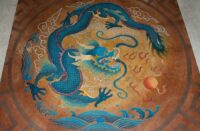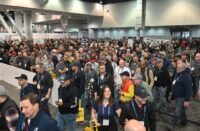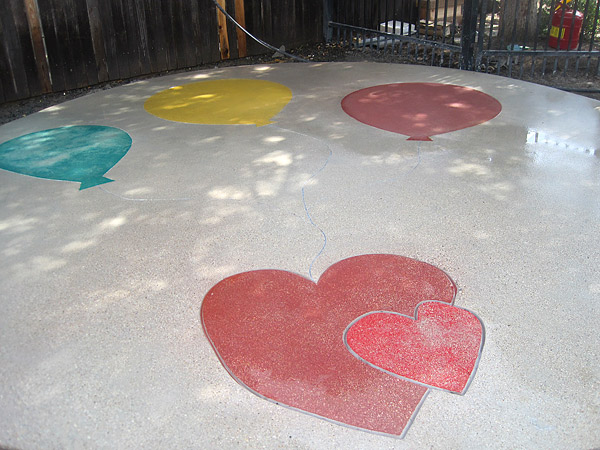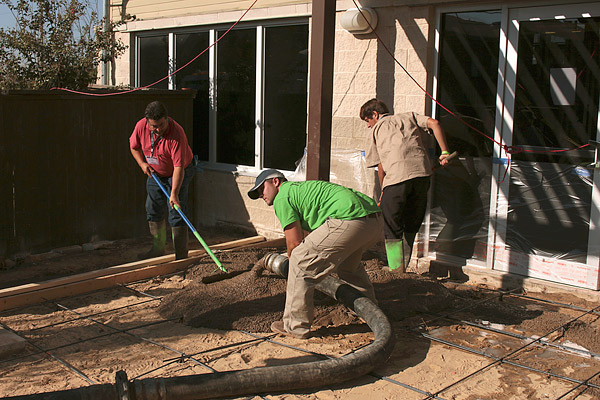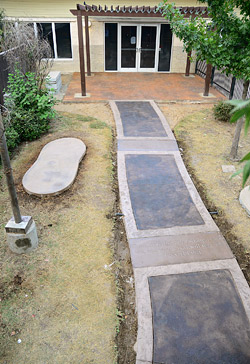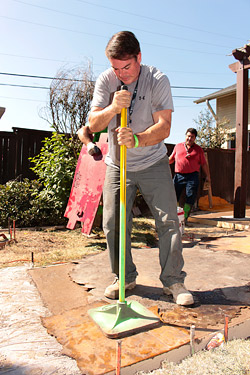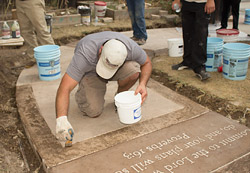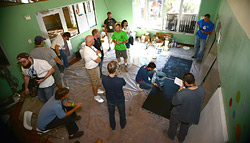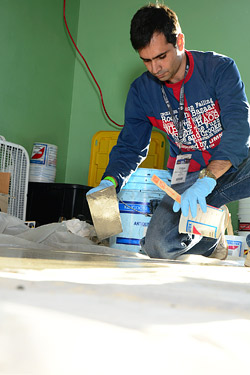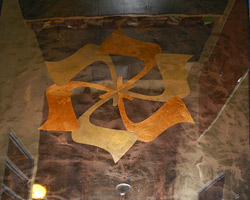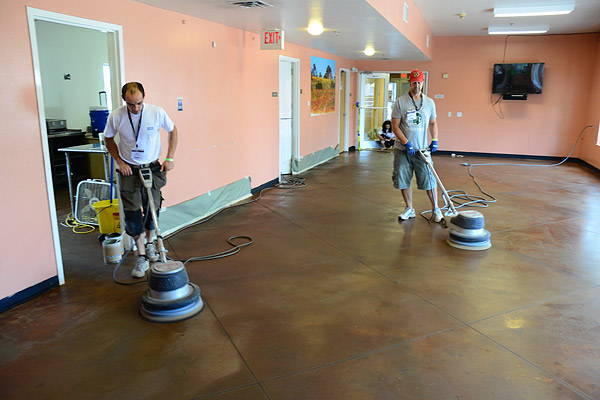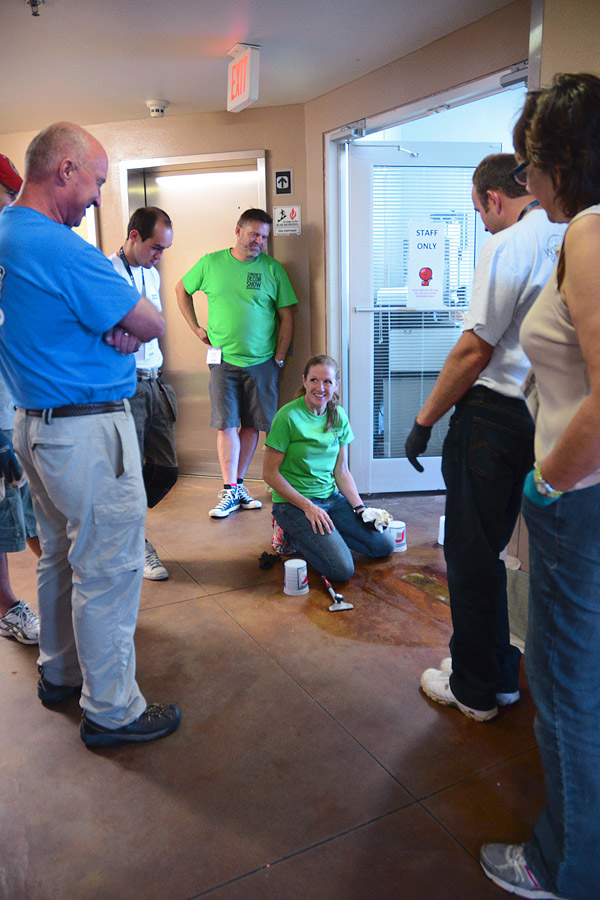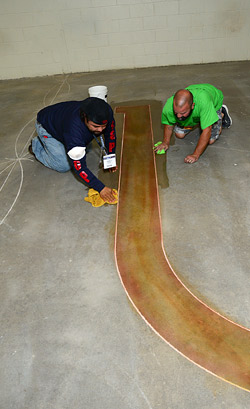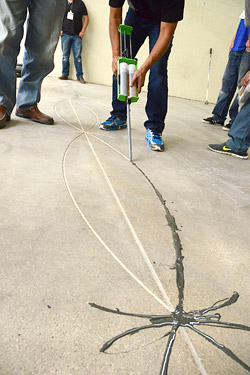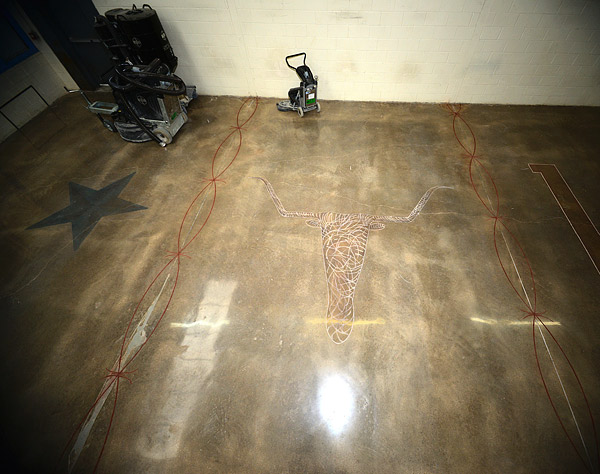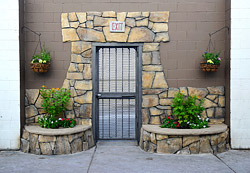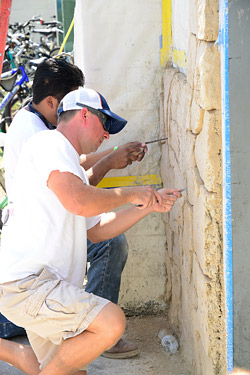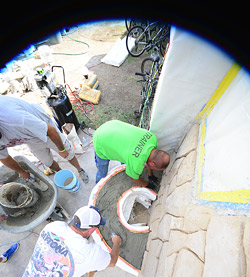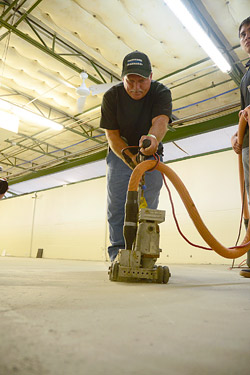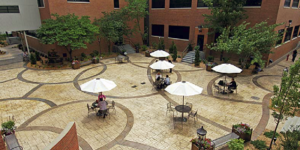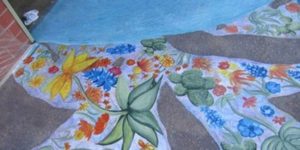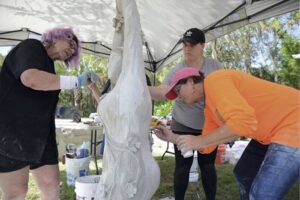This fall, a crew of trainers and the people who signed up to take their workshops transformed much of the Presbyterian Night Shelter in Fort Worth, Texas. Six workshops opened a week of activity surrounding the 2014 Concrete Decor Show held Oct. 1- 3 at the Fort Worth Convention Center. In two days’ time, working primarily during business hours, decorative concrete trainers and their students improved more than 7,000 square feet of flooring, replaced a lackluster patio and walkway, and created a carved rock entryway fit for a castle.
“Since you finished the work there’s been nothing but positive comments,” says Toby Owen, chief executive officer of the shelter. “The residents, staff and everybody are very pleased.”
2014 was the fifth year of the Concrete Decor Show, which travels to a new host city each year. Part of the show’s mission is not only to provide training opportunities but to put talent and high-quality products to good use. Rather than applying products to concrete that gets discarded at the end of the event, the workshops allow the show to give back to the host community in a tangible way, leaving a city better than it was before the show.
The 2010 show transformed several areas of the Children’s Museum of Phoenix. In Nashville, the 2011 show projects centered around a popular youth center called Rocketown. In 2012, trainers and students in San Antonio went to work at a youth art center called SAY Sí. Last year in Charlotte, North Carolina, similar projects were undertaken at the Charlotte Rescue Mission.
On with the show
This year’s community project helped out the Presbyterian Night Shelter, the largest provider of homeless services in the area. “Total capacity is 667 people,” says Owen, “and we’re averaging 650 a day.” It is the area’s only shelter that allows residents to stay as long as necessary.
The shelter spans both sides of a street, with facilities for single people on one side and a shelter for women and children on the other. Shelter staff purchased an adjacent plot of land, which they plan to develop in the near future.
When CEO Owen was first approached about the possibility of improving the shelter, he welcomed the idea. “I’m really thankful for all you did for us,” he says. “It brightens it up and makes it more of a livable place.”
This year’s workshops at the Presbyterian Night Shelter focused on improving the following six areas:
Women and Children’s Courtyard
Course: Imprinted Concrete and Inlayed Graphics
Lead Trainer: Brian Farnsworth, Cement Colors Inc.
Product and materials donated by: Kingdom Products – 2014 Color Sponsor, Airlite Plastics, Cement Colors – 2014 Supply Store, Chapin International, Helix Color Systems, CMC Commercial Metals, Cow Town Redi-Mix Concrete, Dustless Technologies, Engrave-A-Crete, Fritz-Pak Concrete Admixtures, Kraft Tool Co., Proline Concrete Tools, QC Construction Products and Sunbelt Rentals.
The courtyard’s existing 30-by-20-foot patio and 50-by-3-foot walkway were torn out and completely replaced with stamped and colored concrete about the same size or slightly larger. The new walkway included three engraved Bible verses.
In addition to the patio and walkway, trainer Brian Farnsworth built a 15-by-15-foot picnic table pad under a shade tree — a space where moms and their children now enjoy together. The pad is engraved with a heart pattern and colored with balloons.
The Children’s Library
Course: Adding New Dimensions with Metallics
Lead Trainer: Troy Lemon, Cornerstone Decorative Concrete
Products and materials donated by: Airlite Plastics, BN Quality Products, Dustless Technologies, Flex Das Original, GranQuartz, HTC, Key Resin Co., Kingdom Products – 2014 Color Sponsor, Kraft Tool Co., MSA Safety Works, Merit Trade Source, Midwest Rake, Sunbelt Rentals, VersaFlex, Wooster and Xtreme Engineered Floor Systems.
The library floors in two 17-by-14-foot rooms, housing computers and children’s books, both had challenging joint patterns that had to be removed before work could progress. Trainer Troy Lemon said the joints went down deeper than his blade.
To prepare them for the microtopping and metallic work, the class first made sample boards. The job involved stenciling one room with a metallic blue and silver design. The other room was stenciled with a pattern Lemon created based on the first letter of the Hebrew word “yovel,” meaning “jubilee.” The symbol represents freedom from bondage and forgiveness from God.
The Women and Children’s Cafeteria
Course: Aesthetic Restoration and Repair
Lead Trainers: Shellie Rigsby Cordell, Acanthus, and Randall Klassen, Klassen Concrete
Products and materials donated by: Airlite Plastics, Chapin International, Dustless Technologies, Franmar Chemicals, GranQuartz, Kemiko, Merit Trade Source, MSA Safety Works, Padco, Preval and Sunbelt Rentals.
The 4,000-square-foot cafeteria in the women and children’s wing needed a lot of work. One of the facility’s largest rooms, it presented several logistical challenges because it was adjacent to the cafeteria and kitchen used by women and children residents. Because it’s part of their living space, it could not be completely closed off to foot traffic.
The trainers, Shellie Rigsby Cordell and Randall Klassen, and students first thoroughly cleaned the entire floor. The floor was swept, washed and buffed with a swing buffer.
Overall, color was reapplied and corrected. A seal coat and subsequent paste wax was then applied to finish the project, leaving the shelter with a low-maintenance floor.
Prior to the beginning of class, Soy Gel by Franmar was used along the entryway to remove old sealer. The crew used spray bottles of acid stain to color-correct, particularly in areas where the color had been walked off, and in places where existing walls had been removed and the underlying color did not match the rest of the floor.
“It’s looks great,” says Owen. “The work brightened the room. The floors are clean and there’s more sitting room outside, which is great for the clients.”
Men’s Sleeping Quarters
Course: Beyond the Basics: Decorative Effects for the Polishing Contractor
Lead Trainer: Jeremy Wilkerson, DreamKrete
Products and materials donated by: Chapin International, Concrete Polishing Association of America, Engrave-A-Crete, Flex Das Original, FLOORmap Stencil Designs, GranQuartz, HTC, Iwata Medea, Kingdom Products – 2014 Color Sponsor, Merit Trade Source, Metzger/McGuire, MSA Safety Works, Prosoco, Sunbelt Rentals and VersaFlex.
The concrete in this long, rectangular 1,500-square-foot sleeping quarters, which holds bunks for 44 men, had many flaws. It was not only unappealing but the concrete was broken and chipped.
Course participants had to do spall repair at a control joint, where a piece of rebar was exposed. They made fresh cuts, removed all loose material and filled the joint with VersaFlex Quick Mender. Lines were then etched into the concrete along the joints with a Mongoose concrete engraving saw to mimic barbwire. Polyurea joint filler was used as a decorative element to add color where the saw-cuts were placed in the barbwire pattern. Where the pattern needed adjustments, participants removed the joint filler and replaced it with sanded grout in a terra cotta color.
Three other decorative elements were added: a stenciled, metallic Texas lone star, an engraved and stained Texas longhorn steer and a stained horseshoe.
Near the back wall of the room, the students used the engraving saw to carve several symbols that look like old-fashioned western cattle brands. The floor was polished to a 3,000 grit.
“At the main shelter,” says CEO Owen, “this room is one of the two things that have received the most comments by the staff and the residents. I absolutely love how the cleaned and polished concrete looks.”
Bicycle Entrance to the Men’s Area
Course: Going Vertical in a Flat World
Lead Trainer: Nathan Giffin, Vertical Artisans
Products and materials donated by: Airlite Plastics, Flex-C-Ment, Kingdom Products – 2014 Color Sponsor, Kraft Tool Co., Merit Trade Source, Preval and Smith Paint.
Throughout the project’s two days, Nathan Giffin’s work in an outdoor area near a men’s entryway was the most observed. It was not unusual to find a group of residents and staff sitting at picnic tables under the building’s overhang to watch him work. In the end, he and his students transformed a plain doorway with a locking metal door surrounded by white-painted cement blocks into what looked like the entrance to a stone castle.
Giffin and his students first prepped the wall and sprayed it with mortar. When the wall was partially done, they added a curved Styrofoam-molded bench complete with planters on both sides of the doorway. After carving this to mimic rocks, Giffin demonstrated various coloring techniques using water-based stains to make them look more realistic.
The Loft
Course: Advanced Coloring Techniques with Acid Stains
Lead Trainer: Rick Lobdell, Concrete Mystique Engraving
Products and materials donated by: Airlite Plastics, Dustless Technologies, Engrave-A-Crete, FLOORmap Design Stencils, GranQuartz, HTC, Kemiko, Kingdom Products – 2014 Color Sponsor, Kraft Tool Co., Lyon Manufacturing, Midwest Rake, Merit Trade Source, MSA Safety Works and Preval.
The 1,500-square-foot loft is used as a day lounge for war veterans as well as an overflow sleeping area for homeless women. Its floor, like the hallways and most of the flooring throughout the building, was mechanically ground before an overlay was applied. Lobdell used a fresh, lighter color on the main floor and a darker border around the room’s edges, using a 1:1 dilution of a black acid stain.
In the middle of the room, Lobdell and his students engraved and acid-stained an eagle with a 28-foot wingspan. Owen says the new and improved loft doesn’t look “so institutional” anymore. The eagle “has livened up everything.”
A big thanks is extended to the 2014 show sponsors:
Buddy Rhodes Concrete Products
Delta Performance Products
EZChem USA
SureCrete Design Products
2014 Color Sponsor Kingdom Products
2014 Supply Store Cement Colors Inc.
